Welcome to our comprehensive guide on growing and caring for Snapdragon flowers! Whether you’re a gardener or just starting, this step-by-step explanation will give you the information you need to cultivate these stunning flowers successfully. Snapdragons, known for their vibrant colors and unique shape, can add a touch of charm to any garden. We’ll cover everything from understanding the ideal soil and sun requirements to mastering watering techniques and schedules. You’ll also learn about propagation, pruning, fertilizing, etc.
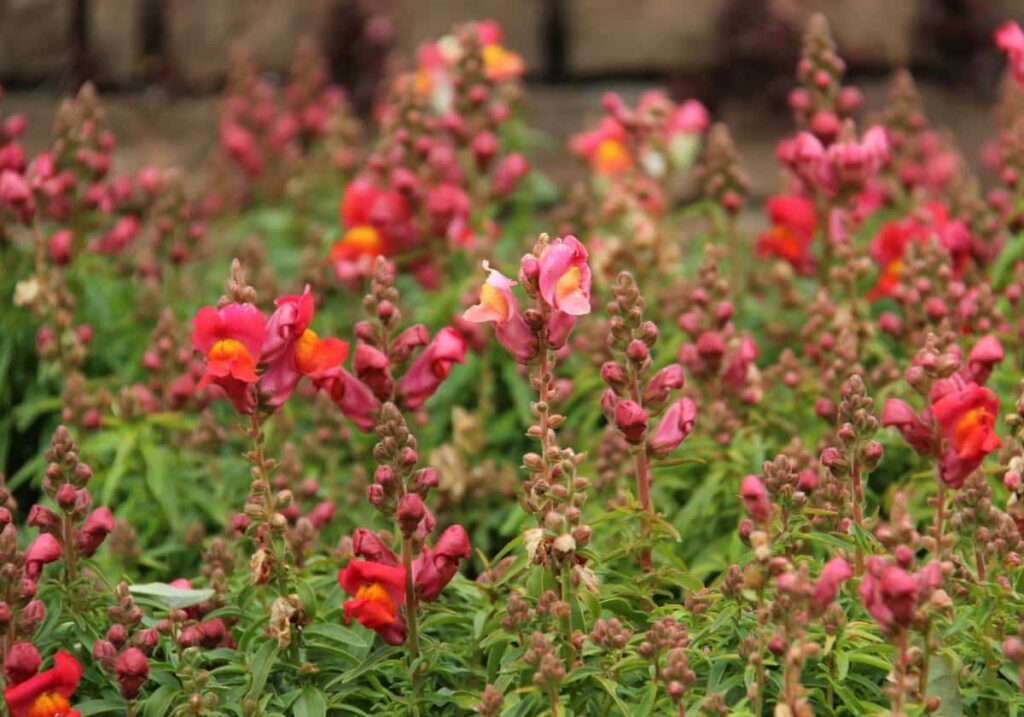
How to Grow and Care for Snapdragon Flowers
What are Snapdragon Flowers?
Snapdragon flowers, scientifically known as Antirrhinum majus, are incredibly popular and versatile plants in garden landscapes. While they are typically grown as annuals, they are technically short-lived perennials. The name “Snapdragon” comes from the unique shape of their flower heads, which resemble a dragon’s snout and have the fascinating ability to open and close like snapping jaws.
These flowers come in a differnt range of intensely saturated colors, adding vibrancy to gardens during cooler weather in spring or fall. Snapdragons have alternate, lanceolate leaves that spiral around the stem, and they rely on bumblebees for pollination due to the flower’s structure. They bloom from the bottom of the stalk upwards, providing an extended flowering period.
Although they may slow down during summer heat, regular watering can help them thrive and continue blooming into the fall. Snapdragons exhibit various sizes, from dwarf to towering spires reaching up to 4 feet. Breeders have even developed trailing and creeping varieties, making them suitable for containers, hanging baskets, and crevices in garden walls. It takes 2-3 months for snapdragons to go from seed germination to flowering, so starting them indoors before the last winter frost is common.
Best Practices for Growing Snapdragon Flowers in Your Garden
- Plant snapdragons in temperatures between 40 and 80 degrees Fahrenheit for optimal blooming.
- Choose well-draining soil and containers with drainage holes when starting snapdragons from seeds.
- Plant established snapdragons in a sunny spot with well-draining soil, ensuring the root ball is slightly larger than the hole.
- Water regularly, avoid overhead watering to prevent fungal infections, deadhead wilted flowers, trim stalks with seed pods, and mulch around the plants.
- Continue watering through summer to encourage fall/winter bloom.
In case you missed it: Optimizing Indian Gooseberry/Amla Orchard Management: A Month-by-Month Operation Guide for Maximum Yield
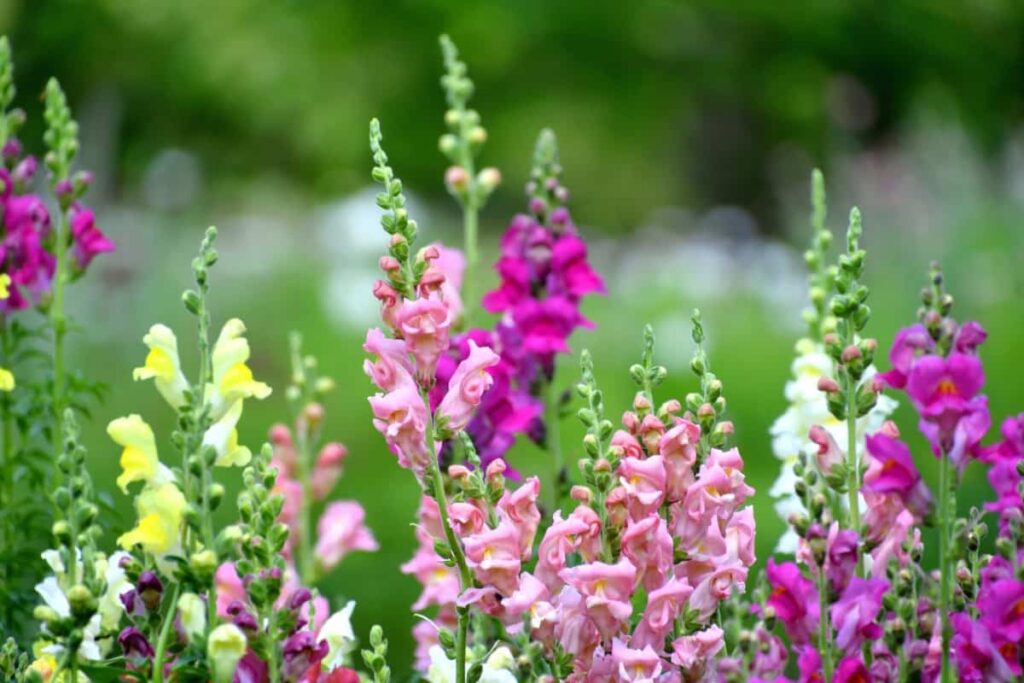
Snapdragon Varieties to Grow at Home
Snapdragons offer a variety of options for your garden. While often sold in multi-color blends, unique colors can also be found. Notable series include the Rocket series, known for its reliability and height of 2-3 ft. Madame Butterfly mix features tall plants with ruffled flowers, perfect for cut-flower arrangements.
Tutti Frutti offers shorter plants with speckled and striped flowers. Candy Tops mix is compact and comes in solid tones, ideal for edging. Chandelier mix is a trailing variety with lilac, pink, or yellow flowers. These choices will bring vibrant colors and unique characteristics to your garden.
How to Propagate Snapdragon Flowers and Expand Your Garden
Snapdragons can be propagated from stem cuttings or grown from seeds. For stem cuttings, take a 2-inch section from a healthy plant, dip it in the rooting growth hormone, and plant it in a pot with a seed starter mix. Cover it with a plastic bag or dome until roots develop, then remove the cover and continue growing indoors.
Transplant outside after the last frost. When growing from seeds, sow them directly in the garden or start indoors, providing bright light for 16 hours daily. Pinch off the top when seedlings have six leaves. Transplant outdoors before the last frost.
How to Grow Snapdragon Flowers from Seeds
- Purchase snapdragon seeds based on your desired flower colors. Varieties like the Rocket series (red, pink, yellow, purple, and white), the Sonnet series (red, yellow, pink, purple, and white), and the Liberty series (red, yellow, pink, purple, white, and more) offer great choices.
- Begin indoor seed starting six to eight weeks before the last frost. Use seed substrate in seedling pots, scattering the seeds on the surface and lightly pressing them. Keep the pots in a warm, sunny window and ensure even moisture. Alternatively, plant the seeds outdoors in late fall for early spring emergence. Buying snapdragon seedlings from a nursery is also an option.
- Care for the seedlings by providing adequate water and warmth for six to eight weeks. Once the seedlings sprout and develop leaves, they are ready for outdoor transplanting. Maintain a temperature of 60-70 degrees Fahrenheit.
- Pinch off the stem tips when the seedlings have six leaves to promote more flower growth. This step applies to self-started and store-bought seedlings, ensuring they are strong enough to withstand pinching.
In case you missed it: Berry Orchard Management: Essential Month-wise Maintenance Guide

Understanding the Ideal Soil and Sun Requirements for Snapdragon Flowers
Snapdragons, often grown as annuals, have specific soil and sun preferences. Light: Snapdragons thrive in full sun to partial shade. During hot temperatures, they may stop blooming. Planting them in part shade and ensuring adequate watering helps them survive the summer and potentially bloom again in the fall.
Soil: Snapdragons prefer neutral soil with a pH between 6.2 and 7.0. The soil should be well-draining and nutrient-rich. While they aren’t heavy feeders, adding organic matter promotes their health and blooming.
Water: Snapdragons need enough water. Suppose there’s no rain, water seedlings about 1 inch per week. For plant health, water around the base and prevent overhead watering. Water again once the top portion of the soil dries.
Temperature and Humidity: Snapdragons are tender perennials hardy in USDA zones 7-11. They thrive in low 40s F at night and low 70s F regular day temps. They are often grown as annuals and add color in the spring and fall cooler months. Established plants can withstand sub-freezing temperatures if well-watered and mulched with pine straw. Seedlings that start indoors must be hardened off before planting in the garden, typically for about ten days to two weeks.
Best Time to Plant and Transplant Snapdragon Flowers for Optimal Results
- Prepare the outdoor planting bed before the last frost of early spring. Snapdragons thrive in full sun and neutral soil (pH 6.2-7) enriched with organic matter. Till the soil, apply six inches of organic matter, and ensure good drainage.
- Plant the seedlings around the last frost. Snapdragons can tolerate light frosts.
- Space the seedlings at least 1 foot apart to prevent disease. Snapdragons are susceptible to rust, rot, and mildew. Adequate spacing promotes airflow and prevents these issues. Water the seedlings immediately after planting.
Watering Techniques and Schedules for Healthy Snapdragon Flower Growth
- Water near the crown of the plants: Avoid overhead watering as the pressure can damage the flowers. Watering closer to the roots is more beneficial.
- Water in the morning: Watering in the morning allows the water to be fully absorbed before nightfall. Water sitting around the plants overnight can cause rot or mildew development.
In case you missed it: Maximizing Crop Yields with NDVI
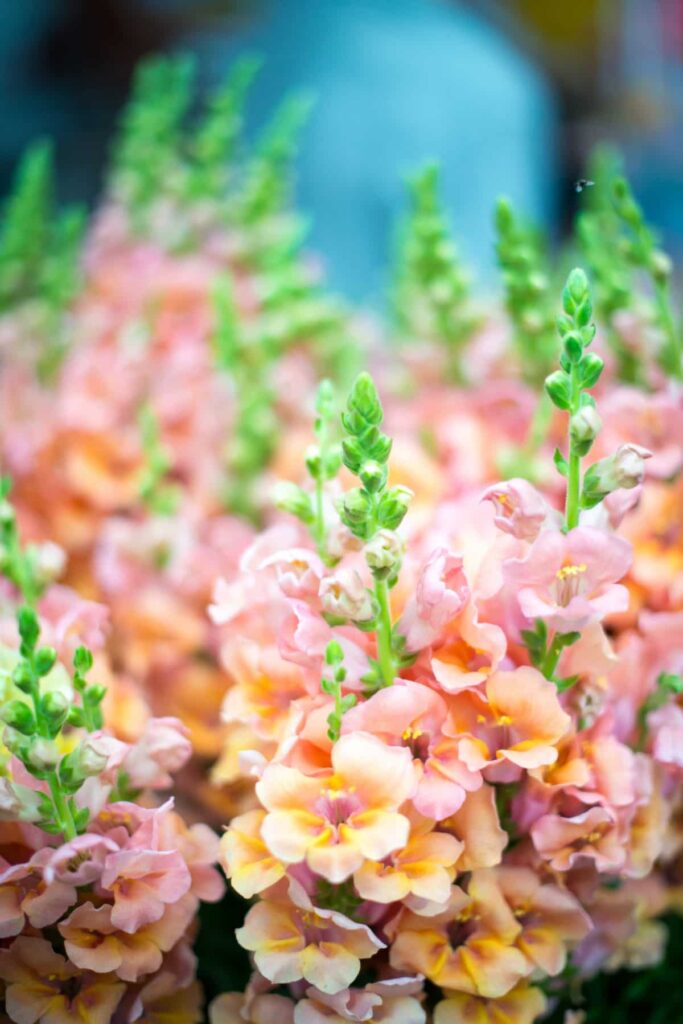
Pruning and Mulching Requirements for Snapdragon Flowers
- Pruning: Remove wilted and faded flowers by pinching them off the stems. This encourages new blooms and maintains plant health.
- Watering: Water the plants when the soil feels dry, avoiding overwatering.
- Mulching: Apply an organic mulch around the base of the snapdragons when the weather gets warmer. This helps keep the root system cool during hot weather and prolongs the plants’ lifespan.
Best Fertilizers for Snapdragon Flowers
- Apply a standard, well-balanced all-purpose fertilizer, like a 10-10-10 product.
- Use a rate of three pounds per 100 square feet of the flowerbed.
- Water thoroughly to prevent nitrogen burns and ensure the fertilizer reaches the roots.
Best Composting and Manures for Best Blooms of Snapdragon
- Use well-decomposed compost to enhance soil quality and nutrient levels.
- Avoid fresh manures to prevent plant burn; choose well-aged or composted manures instead.
- Opt for organic sources to ensure chemical-free compost and manures.
- Maintain nutrient balance with compost and manures rich in nitrogen, phosphorus, and potassium.
- Apply compost and manure moderately to prevent nutrient imbalances and promote healthy plant growth.
Optimal Conditions and Care Routines for Thriving Snapdragon Flowers
Snapdragons can be grown from seeds or nursery seedlings. Optimal conditions include rich, well-draining soil and a sunny location (partial shade tolerated). Pinching stem tips promotes bushier growth while deadheading extends the blooming season. They thrive in spring and fall, blooming throughout the season in cooler climates and even winter in milder regions. Though short-lived perennials, they are commonly grown as annuals. Overwintering snapdragons may not bloom as well, but they form seed pods and can self-sow.
Essential Care Tips for Vibrant Snapdragon Flowers
- Use a well-draining, moist potting mix with compost for poor soil.
- Start seedlings indoors 6-8 weeks before the last frost or plant outdoors in late fall. Keep them watered and warm until leaves emerge.
- Provide 6 hours of direct sun or partial shade, especially in hot weather.
- Water weekly once roots are established, using drip irrigation for gardens and daily watering for pots. Mulch for soil moisture and weed control.
- Fertilize when flowers appear with an all-purpose fertilizer, watering afterward.
- Deadhead faded flowers, prune leggy stems, and sterilize tools.
In case you missed it: How to Grow Leafy Green Vegetables in Hydroponics: A Step-by-step Growing Guide
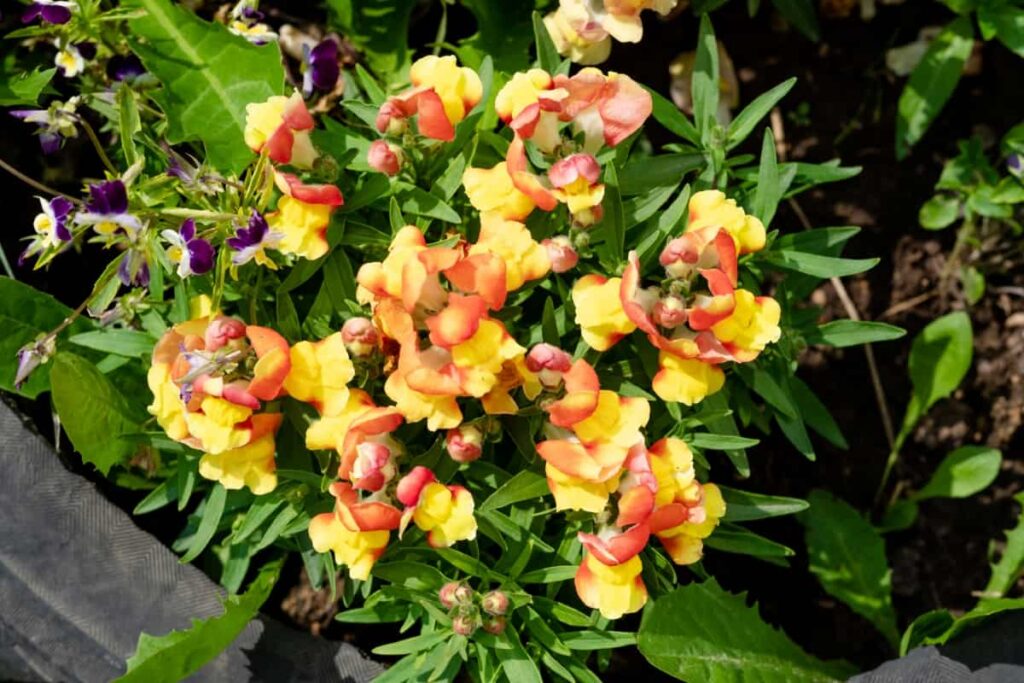
Common Mistakes to Avoid When Growing Snapdragon Flowers
- Overexposure to heat and sunlight: Avoid placing snapdragons in areas with excessive heat and direct sunlight. Move them to cooler, shadier spots to prevent wilting. Pruning can also encourage new blooms and reduce wilting.
- Snapdragon rust: This fungal disease causes yellow flecks on leaves, which may darken and enlarge with brown or black centers. Prevent snapdragon rust by thinning out plants for better air circulation. Additionally, avoid watering snapdragons at night to minimize moisture and fungal growth.
- Toppling plants: Taller snapdragon varieties may become leggy and prone to toppling in shady areas. Provide support to keep plants upright and prevent them from falling over.
Expert Tips and Strategies for Extending the Snapdragon Flower Blooming Season
- Sunlight: Adjust the amount of sunlight your snapdragons receive. So finding the right balance for your plants can help prolong the blooming period.
- Deadheading: Remove faded and dying flowers regularly through deadheading. This practice encourages the plant to produce new blooms and ensures continuous flowering.
Natural Remedies for Preventing and Treating Snapdragon Flower Diseases
You can effectively prevent and treat common diseases and pests in snapdragon flowers by employing natural remedies, ensuring their health and vitality.
Diseases
- Downy and Powdery mildew: Remove infected plant parts and reduce greenhouse humidity for greenhouse-grown snapdragons. Use a sulfur-based fungicide, following the instructions on the leaflet, to spray the plants and control mildew.
- Botrytis blight: Spray affected shoots with a sulfur-based fungicide, adhering to the instructions on the leaflet, to control botrytis blight.
- Rust: Following the recommended application rates, apply a sulfur-based fungicide to the shoots to control rust in snapdragons.
Pests
- Aphids, Whiteflies, Mealybugs, and Mites: Use regular blasts of water from a garden hose or insecticidal soap sprays to eliminate these sap-sucking insects that cause damage to leaves and flowers.
- Flower thrips: Treat the foliage or flowers with an insecticide upon first sighting of flower thrips. Make weekly applications until the infestation is under control. Alternatively, employ predatory mites like Neoseiulus cucumeris as a biological control method.
How to Overwinter Snapdragons
Snapdragons are typically grown as annuals, but if you want to overwinter them, remember that they may not bloom as vigorously as in their first year. However, they should produce seed pods during the first year, and if fortunate, they might self-sow in the garden.
How to Pollinate and Collect Hybrid Snapdragon Seeds
Select two different snapdragon plants with desirable traits to pollinate and collect hybrid snapdragon seeds. Isolate the chosen flowers by covering them with mesh bags to prevent cross-pollination. Repeat between blooms by transferring pollen from the male stamen to the female pistil with a little paintbrush or cotton swab.
In case you missed it: How to Grow Edible Flowers in Hydroponics: A Step-By-Step Guide for Beginners
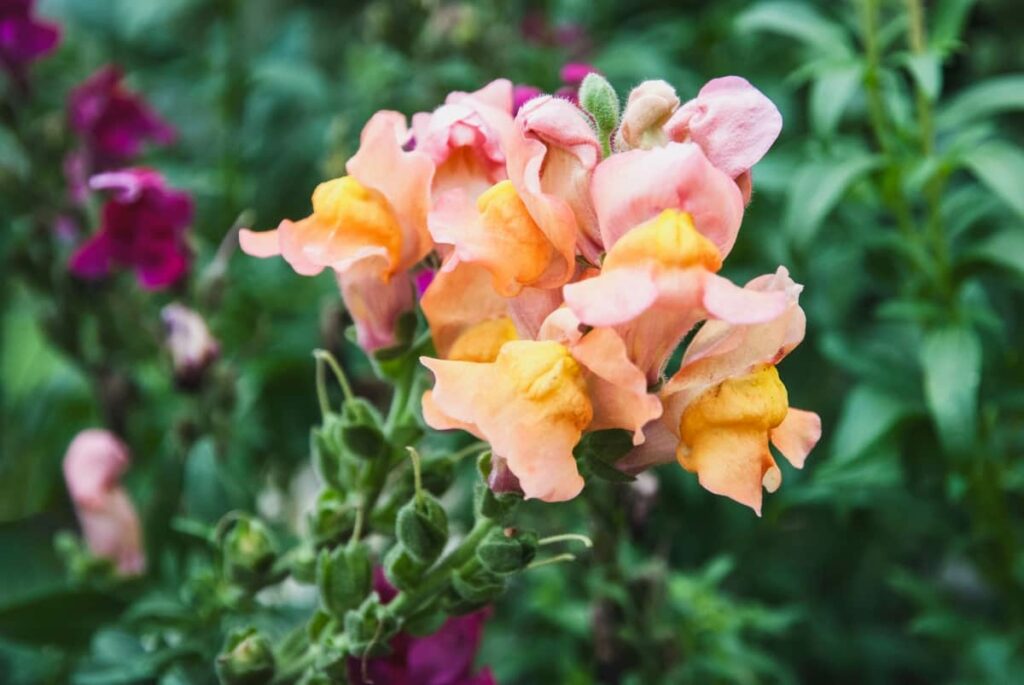
Mark and protect the pollinated flowers with mesh bags to prevent accidental pollination. Allow the pollinated flowers to develop seed pods, which will turn brown and dry as the seeds mature. Carefully remove the dry seed pods, extract the seeds, and label them with the parent plants’ names. Store the labeled seeds in a cool, dry place for future use.
How to Harvest and Store Snapdragon Seeds
To harvest and store snapdragon seeds, wait until the plants have matured and seed pods form near the base of the stalks. Place a brown lunch bag over the pods and allow the seeds to drop into the bag naturally. Once collected, you can dry and store the seeds for planting the following year.
Alternatively, you can drop the seeds into the soil instead of saving them. If you live in a suitable environment, snapdragons may self-seed independently. If you prefer to avoid saving seeds, another option is to cut the snapdragons at the peak of their bloom before they start to fade in the summer heat. This way, you can enjoy the flowers without the need to collect and store seeds.
Conclusion
Following the step-by-step guide, including planting from seeds or nursery seedlings, providing optimal conditions, proper pruning and mulching, and addressing pests and diseases, you can cultivate beautiful snapdragons in your garden.
- Crops Grown in Summer Season: Best Choices for Summer Gardening
- Organic Pest Control for Tomato Farming
- How to Maximize Sheep Farming Profit
- Broccoli Varieties: Choosing the Right Cultivars for Your Farm
- How to Raise Pigs in Your Own Backyard: A Comprehensive Guide
- Budget Friendly Sheep Shed Ideas: Cheap and Low-Cost Tips
- How Much Do Cattle Farmers Make: Revenue Streams in Cattle Farming
- Management Pests and Diseases in Your Cotton Field
- Sheep Farming Business Plan for Beginners
- Aquaponic Farming at Home: A Step-By-Step Guide
- Profitable Village Farming Business Ideas in 2024
- High-Yield Aquaculture: Fast-Growing Fish for Farming
- Effective Fish Pond Construction Techniques for Beginners
- Irrigation and Water Management in Pineapple Farming
- Blossom to Harvest: Mastering Flowering and Pollination in Papaya Farming
- Pig Fattening Essentials: From Selection to Sale for Beginners
- Raising Wagyu Cattle: A Complete Guide for Premium Beef Production
- Soil Types and Their Water Holding Capacity
- Optimizing Irrigation Schedules for Coconut Groves for Enhanced Yield
- Espresso Your Garden: Coffee Grounds for Healthier Acid-Loving Plants
- The Best Soil Mix for Snake Plants: How to Mix Your Own Snake Plant Soil
- Green Thumb Success: Expert Tips for Cultivating Greenhouse Beans All Year Round
- Bloom All Year Round: The Ultimate Guide to Indoor Hyacinth Care
- Eco-Friendly Gardening: How to Make Liquid Fertilizer from Kitchen Waste
- Ultimate Guide to Grow Anise in Pots: Explore Seed Propagation to Harvesting
- Guide to Raising Chester White Pigs: Discover Breed Facts to Growth Management
- Mastering the Elegance: The Ultimate Guide to Weeping Cherry Tree Care, Planting, and Maintenance
- Ultimate Guide to Planting Garlic in Grow Bags: Growing Strategies for Beginners
- How to Fix Spider Plant Leaf-Related Problems: Natural and Organic Remedies
- 10 Reasons Why Your Tulsi Plant is Shedding Leaves: Home Remedies and Solutions
- Optimizing Growth and Yield: The Advantages of Palm Bunch Ash Fertilizer
- Utilizing Neem Oil Extract as a Natural Pesticide for Hydrangea
- From Soil to Harvest: Various Ways in Which Farmers Can Use AI Tools
- Steps to Encourage and Induce Citrus Flowers: A Comprehensive Guide
- How to Fix Snake Plant Leaf-Related Issues: Natural and Organic Remedies
- Transform Your Garden into a Fragrant Oasis with Raat Ki Rani (Night Blooming Jasmine)
